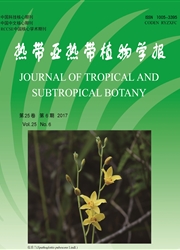

 中文摘要:
中文摘要:
用磷脂脂肪酸法(PLFA)分析广东鹤山两种人工林——针叶林和荷木林不同土层(0-20cm、20-40cm、40-60cm)的土壤微生物群落结构。结果表明,两种人工林的磷脂脂肪酸总量(PLVAs总量)、细菌特征脂肪酸(细菌PLFAs)、真菌特征脂肪酸(真菌PLFAs),以及革兰氏阳性菌和革兰氏阴性菌特征脂肪酸的含量都是0-20cm土层最高;荷木林的PLFAs总量高于针叶林,但这种差异随土壤深度增加而递减,且与土壤有机碳、全氮含量呈正相关。在相同土层,细菌PLFAs含量均显著高于真菌PLFAs含量。主成分分析表明,土壤微生物多样性及其丰富度受林型和土层综合作用的影响;单一的PLFAs中,i13:0、a13:0、17:0、cyl7:0和16:0等脂肪酸对第一主成分的贡献较大;i16:0、cyl9:0、18:1(1)9c、i15:0、18:2(1)6c和a17:0等脂肪酸对第二主成分贡献较大。
 英文摘要:
英文摘要:
The soil microbial community diversity at different soil depths (0-20 cm, 20-40 cm, 40-60 cm) was analyzed by phospholipid fatty acid (PLFA) method in coniferous forest and Schima superba plantation in Heshan, Guangdong Province. The results showed that the amounts of total PLFAs, bacterial PLFAs, fungal PLFAs, Gram positive bacterial PLFAs and Gram negative bacterial PLFAs were the highest at 0-20 cm soil layer and decreased with increasing soil depth; the total PLFAs in Schima superba plantation was higher than that in coniferous forest, and was positively correlated with soil organic carbon and total nitrogen in the plantations. In the same soil layer, the concentration of bacterial PLFAs was higher than fungal PLFAs. Principal component analysis (PCA) indicated that the variation in soil microbial biomass and community structures were influenced by the differences of plantations and soil depth, PC1 was mainly composed of fatty acids of i13:0 ,a13:0、17:0、cyl7:0 and 16: 0, and PC2 mainly composed of i16: 0、cyl9: 0.18: lω9c,i15: 0,18: 2ω06c and a17: 0.
 同期刊论文项目
同期刊论文项目
 同项目期刊论文
同项目期刊论文
 Effects of understory removal and tree girdling on soil microbial community composition and litter d
Effects of understory removal and tree girdling on soil microbial community composition and litter d Subtropical plantations are large carbon sinks: Evidence from two monoculture plantations in South C
Subtropical plantations are large carbon sinks: Evidence from two monoculture plantations in South C Impacts of understory species removal and/or addition on soil respiration in a mixed forest plantati
Impacts of understory species removal and/or addition on soil respiration in a mixed forest plantati Understory plants can make substantial contributions to soil respiration: Evidence from two subtropi
Understory plants can make substantial contributions to soil respiration: Evidence from two subtropi Effects of understory removal and nitrogen fertilization on soil microbial communities in Eucalyptus
Effects of understory removal and nitrogen fertilization on soil microbial communities in Eucalyptus Tree girdling affects the soil microbial community by modifying resource availability in two subtrop
Tree girdling affects the soil microbial community by modifying resource availability in two subtrop 期刊信息
期刊信息
